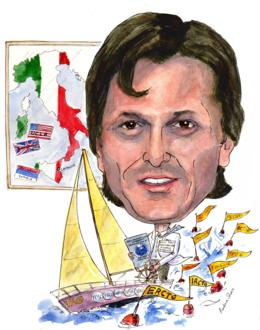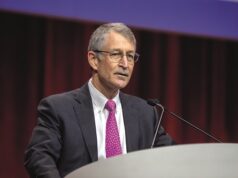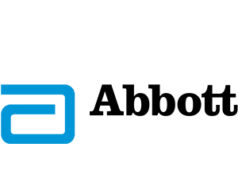
Alfredo R Galassi, director of diagnostic and cardiovascular interventional laboratory, Ferrarotto Hospital University of Catania, Italy, and associate professor of cardiology, University of Catania, Italy, tells Cardiovascular News International about his career journey to date, and his love of sailing.
How did you get into cardiovascular medicine?
My father was a cardiologist and one of the pioneers of cardiology in Sicily. During my studies at university I was fascinated by heart surgery as I have always liked to work with my hands. Thus, after my medical degree, my father let me follow my instincts and I flew to the United States to spend a short time at the University of California, Los Angeles with Dr Lucio Parenzan, a very famous paediatric heart surgeon in Bergamo, Italy. During my short stay, I attended a heart transplantation programme, and I met many cardiologists and heart surgeons, and among them one young heart surgeon who made me think about life. At that time, heart surgeons had very bad life, with a lot of work abroad and little chance to get back to work to Italy. So as soon as I was back in Italy, I changed my mind and I started to specialise in cardiology. Now I can say that I made the right choice, but my father never forced me to do that.
Who have been your mentors?
My first scientific mentor was Professor Attilio Maseri. As soon I finished my medical degree, I moved to London. During those years “Pisa” angina was famous around the world and Attilio Maseri was one of the great leaders in Europe and the United States for having conducted a lot of research into the cause of vasospastic angina and also angina in patients with normal coronary arteries. I was fascinated by his great ability to describe physiopathological causes of cardiac diseases in the most natural way you can imagine. At Hammermsith Hospital, I matured as a research fellow. It was a very friendly atmosphere and we got to interact with some brilliant guys who visited Hammersmith from all over the world. I was very interested in research and I was deeply involved in the area of coronary disease and cardiac syndrome X as well as cardiovascular physiopathology. Nuclear cardiology and positron emission tomography at that time was one of the tools used to better understand the mechanisms of microvascular angina and I started my projects in nuclear medicine with Terry Jones at the Medical Research Council in Hammersmith, where I have been for two years.
After a road accident in London I had to rest for a while and I underwent few orthopaedic operations. This was the time to think about my life and my future. I planned to go back to Italy for a working period in the clinical setting in the North in both nuclear cardiology and interventional cardiology. I then moved back to Sicily where at that time interventional cardiology was developing. There I started my career as an interventional cardiologist with Professor Giuseppe Giuffrida, who was one of the pioneers of interventional cardiology at that time in Sicily, and with Corrado Tamburino, his youngest associate professor with whom I began to be fully immersed in all kinds of interventional procedures. I must admit that reaching the interventional field after a long period in non-invasive imaging and physiopathological studies helped me to approach cardiac disease differently.
Who have been the greatest influences in your interventional career?
When I met Dr Masahiko Ochiai, one of the greatest chronic total occlusion interventionalists in the world, I was really impressed by him. It was during the Singapore Live Course on Coronary Intervention in 2004, my first live session as an interventionalist outside of Europe. At that time he was performing a percutaneous coronary intervention by using a new retrograde approach. I then had the opportunity to attend his lab and invite him to Catania in Sicily where he taught me a lot. I will always remember his first words to me when I was assisting him at the table in these complex procedures. “Please keep the wire and do nothing more,” he said. He has been a great mentor and a very good friend to me. I always seek his advice of him in the field of complex percutaneous coronary intervention and he always gives me great suggestions and new ideas.
What have the proudest moments in your career been?
There is no doubt that being able to reach a recanalisation standard following the Japanese approach and being invited around Europe and all parts of the world to perform coronary interventions in complex patients has been for me one of the most rewarding experiences as an interventional physician.
Perhaps my proudest moment, which I will remember for the rest of my life was during the the opening ceremony at ECC 2009 in Taormina when I called my father onto the podium to present him with a plate on which was written: “To Prof Alberto Galassi, a pioneer of Sicilian cardiology, my father, that his example taught me how to distinguish, above all, the substance from the appearance.”
How far do you think it is possible to go with regard to percutaneous coronary interventions and percutaneous structural valve replacement and repair?
During the last few years interventional cardiology has reached the goal of achieving great success for both coronary arteries and percutaneous valve replacement and repair. This was a far-reaching goal many years ago, and the use of drug-eluting stents has made this success possible, keeping the results of very difficult procedures in complex coronary anatomy as well as new miniaturised structural devices for valve replacement and repair.
What was the most memorable case you have ever treated?
The most memorable case was my first retrograde recanalisation coronary procedure in a chronic total occlusion. The patient was the best friend of the general hospital director; the procedure lasted five hours and gave him a significant improvement in symptoms after the recanalisation procedure. However, the most remarkable moment happened two years later when the patient came back with acute coronary syndrome and, despite severe progression of coronary artery disease on all other coronaries, the recanalised right coronary artery was still patent and life-saving for his condition. Since then my life as an interventionalist changed so much as I understood that these kind of procedures would have changed the prognosis of these patients too.
In your opinion, how has invasive Japanese cardiology impacted on European expertise?
Technically, chronic total occlusion is the last challenge in interventional cardiology. Recanalisation of a chronic total occlusion by percutaneous coronary intervention is a demanding procedure, which requires a lot of work and experience to refine the technique. In this regard the Japanese approach to percutaneous coronary intervention is a different school of teaching. Japanese interventionalists such as Dr Osamu Kato have taught Europeans how important it is to “work hard with faith in order to enjoy all the fruits”. As I wrote in my book, Galassi’s Tips and Tricks for Percutaneous Coronary Interventions for Chronic Total Occlusions, the success of recanalisation is based on careful review of the film, taking time and following careful advice from your “mentor”. However, “hands-on experience” is something that you cannot explain with words but you need to gain from the table by your own hands.
What are the main goals for Europe in the field of complex percutaneous coronary intervention?
On 14 December 2006, the EuroCTO club was founded as a union of highly experienced and dedicated European chronic total occlusion operators who wanted to exchange their experience and practice, and try out new techniques and strategies in the field of revascularisation of chronic total occlusions. In the wonderful scenario of Taormina, in Sicily on 30 and 31 October 2009, the first annual meeting of the EuroCTO club was held. The course faculty consisted of chronic total occlusion world experts, including the most important Japanese and American operators, who presented state of the art lectures and provided very interesting live taped cases which were discussed interactively among the entire audience by a “tele-voting” system. Almost 300 attendees from various European countries participated at the course. The opening ceremony, chaired by myself as course director began with a tribute to Andreas Gruentzig and showed an exclusive original interview he gave to Burt Cohen in September 1985, only weeks before his tragic plane crash. In the interview it was impressive how well Andreas Gruentzig predicted so much of the field’s future concerns about complex percutaneous coronary intervention, underlining almost 25 years before that, “If we cannot solve the total closure problem, we will probably never really address the question of multivessel disease dilatation.”
Outside of cardiology, what other interest do you have?
My first love is sailing and I have practised it since I was very young. I won the Italian IMS championship twice, in Sanremo in 2006 and Cagliari in 2007 after having raced for more than 25 years. I have got a very good trained team mainly constiting of friends, with myself as helmsman and skipper of the boat. But, like the percutaneous coronary intervention approach for chronic total occlusion, you need to have a lot of experience mixed with a lot of practice. The boat is named VAG, which stands for the initials of my beautiful children Vittoria and Alberto who are the richness of my life.
What would you say to your fellows when they start to perform percutaneous coronary intervention in complex lesions?
I always remind them that if they are afraid of losing, they will probably lose. If they try hard to win they will probably be able to win the great challenge.
Fact File
Education and postgraduate training
1984–1986 MD medicine, University of Catania, Italy
1986–1988 Diploma in cardiology, Royal Postgraduate Medical School, University of London, UK
1988–1991 Specialisation in cardiology, University of Catania, Italy
1991–1993 Specialisation in nuclear medicine, University of Bologna, Italy
Fellowship training and appointments
1986–1991 Research fellow/registrar, cardiovascular research unit, Royal Postgraduate Medical School, Hammersmith Hospital, London, UK
1987–1988 Recipient of two ARMED fellowships, within the cardiovascular research unit of the Royal Postgraduate Medical School of Hammersmith Hospital,
1988–1990 Research nuclear cardiology investigator for the Medical Research Council, Cyclotron Unit, Hammersmith Hospital
1990–1992 Recipient of a Consiglio Nazionale Ricerche (CNR) fellowship, Institute of Medical Radiology, Institute of Bioimages and Physiopathology of Central Nervous System,
University of Catania
1994–1996 Registrar at the Institute of Cardiology, Ferrarotto Hospital, University of Catania
1996–2005 Senior registrar at the Institute of Cardiology, Ferrarotto Hospital, University of Catania
2005– Director of diagnostic and cardiovascular interventional laboratory, Clinical Division of Cardiology, Ferrarotto Hospital, Catania
2006– Associate professor of cardiovascular medicine, Faculty of Medicine and Surgery, University of Catania
Prizes and qualifications
Awarded three prizes for research in cardiology, awarded the diploma of Scholar in Cardiologia, fellow of the European Society of Cardiology (FESC), fellow of the American College of Cardiology (FACC). Fellow of the ANMCO (Associazione Nazionale Medici Cardiologi Ospedalieri), fellow of the Italian Society of Invasive Cardiology (Gruppo Italiano di Studi Emodinamici [GISE]). Fellow of the Society for Cardiovascular Angiography and Intervention (SCAI).
Selected board appointments and editorial boards
- National Councillor 2001–2005 of the Italian Society of Interventional Cardiology (SICI) Gruppo Italiano di Studi Emodinamici (GISE). Coordinator of the research group for the Italian Society of Cardiology in the field of Cardiologia Nucleare for the period 2006–2007.
- Awarded the title of elected member for the accreditation of the European Association of Percutaneous Cardiovascular Interventions 2008
- Executive member of the board of the European CTO Club 2008
- Editorial board member for American Journal of Cardiology, Italian Heart Journal, Giornale Italiano di Cardiologia Pratica
Live case demonstrations and scientific medical courses
2004– Co-organiser and first operator at more than 50 live case demonstrations at international meetings and interventional courses on complex percutaneous coronary interventions
(bifurcations and chronic total occlusion lesions treatment) around Europe and East Asia
Major publications
103 original peer-reviewed papers, 28 editorials and reviews, three book chapters; more than 232 abstracts; author of one book and co-author of another book
Major field of research
Invasive cardiology and percutaneous coronary intervention of complex procedures, stents, nuclear cardiology and cardiovascular imaging, acute coronary syndrome













